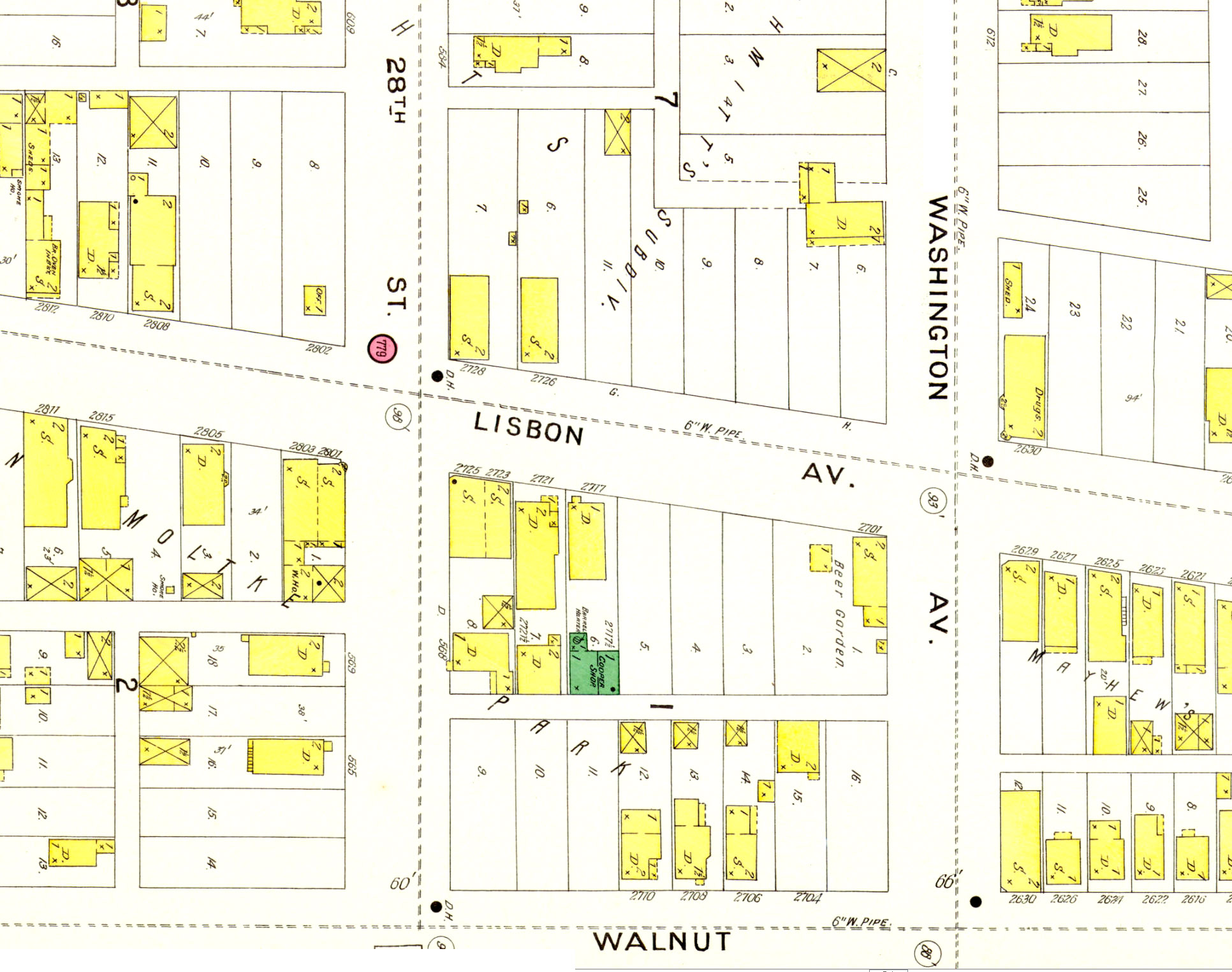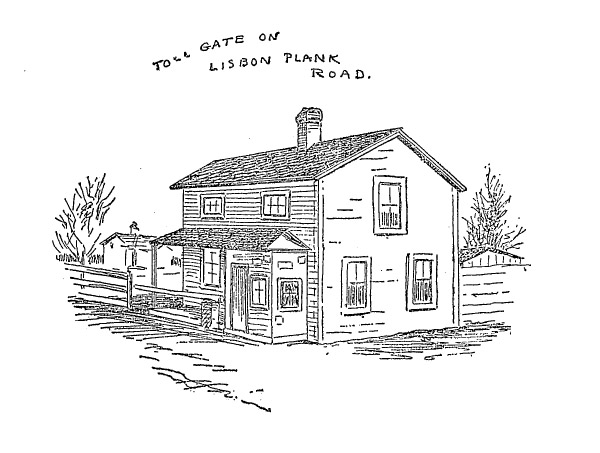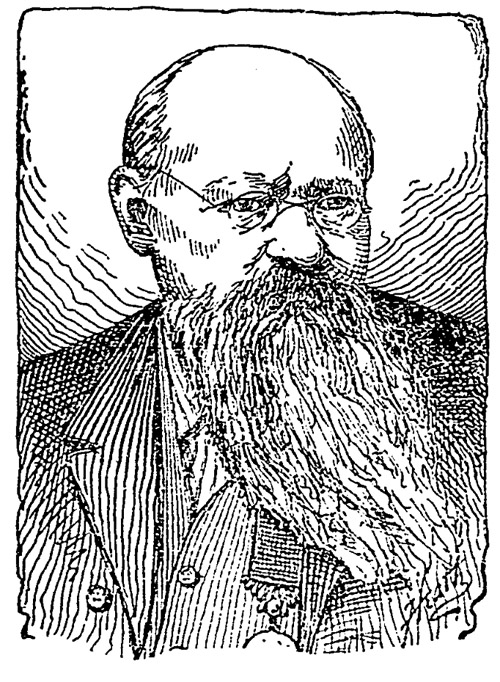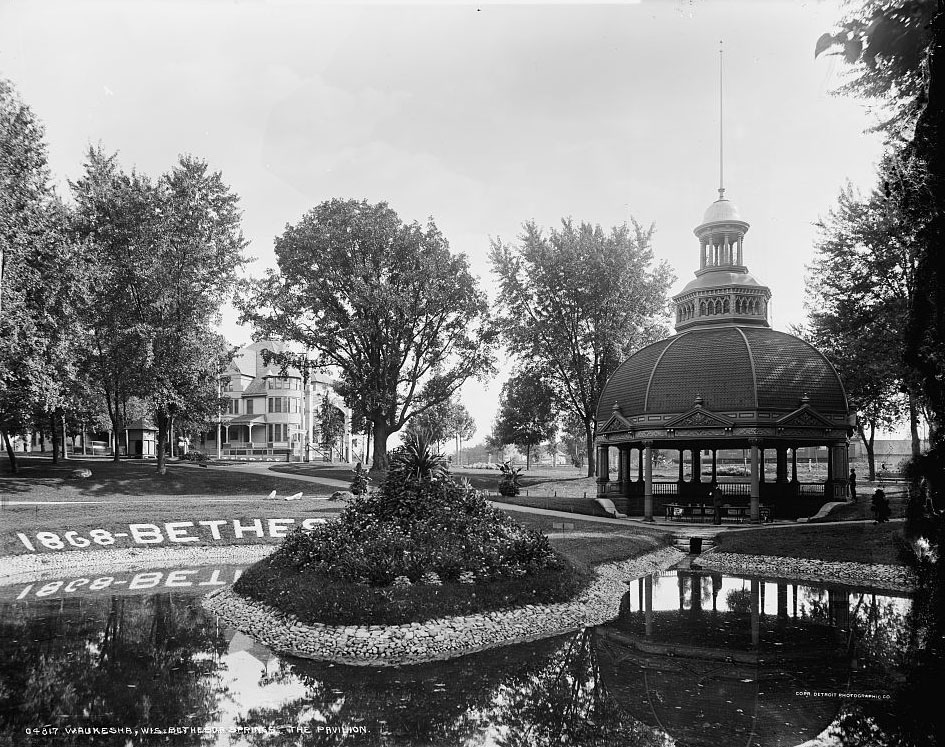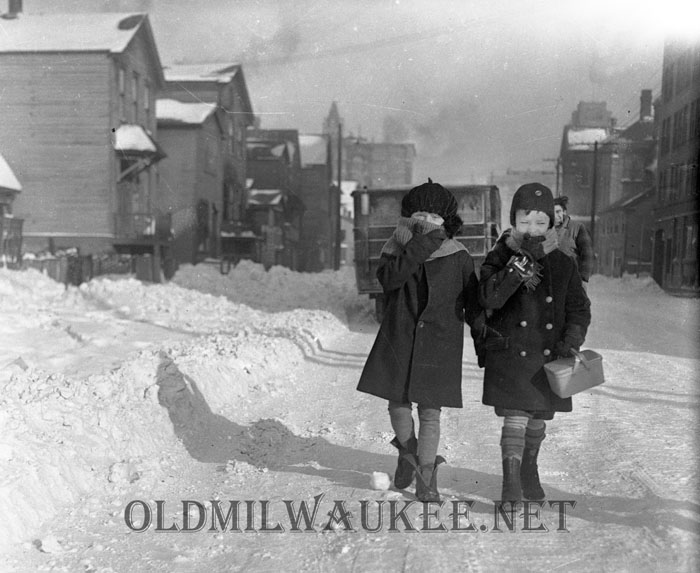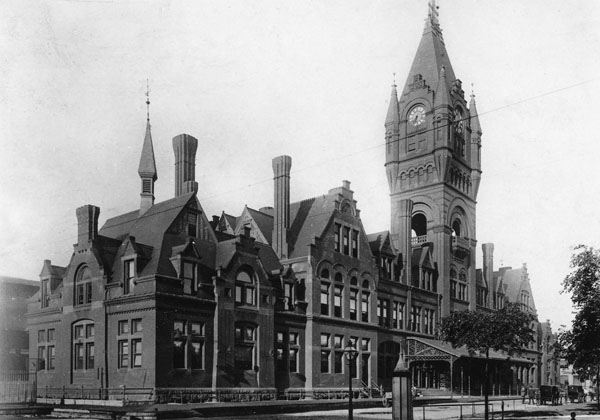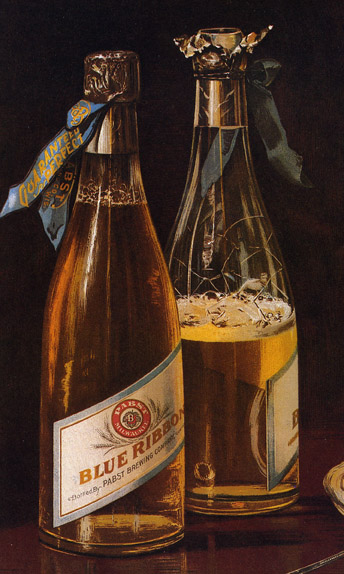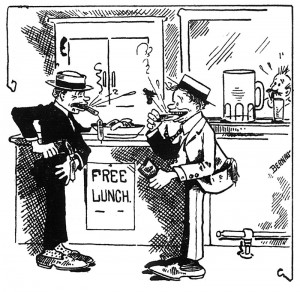Here is a longer than usual article from a magazine that existed back in the late 1800s and was published locally. It’s an interesting magazine which I found on Ebay for a bargain price due to a missing cover on the bound copy of the volume. Thanks to the magic of a scanner with optical character recognition I scanned this article and made some minor corrections to the electronic copy. Here is the article without the illustrations. A pdf copy can now be found here. There also is another article about the city in the magazine from February 1875 which I have scanned here.
The Milwaukee Monthly Magazine – January 1875
Milwaukee
Spring street, is on the West Side. Here one gradually leaves business with its bustling activity, the crowding and jostling of the lower portion, behind, and finds the street broadening into a fashionable, much-frequented avenue. This street runs west, commencing at the river, and the streets crossing it are numbered from that point. On Spring, occupying the block between Ninth and Tenth streets, is the Hon. Alexander Mitchell’s magnificent Northern home. None other in the city or in the state approaches it in beauty and extent. The house is in the modern Italian style of architecture, and has nothing of that look too common to very large houses, of being merely a huge pile of stone raised by its possessor as a monument to his own money, but rather the hospitable sunny expression of the elegant, commodious dwelling place of social-hearted people — people of great wealth, it is true, but who are warmhearted, sensitive and charitable.
There are two entrances to the place, one on Ninth street leading straight up to the house, the principal one on Spring street, where a gate of the most elaborate and handsome design opens to a fine driveway curving through the grounds. On either side of the gate are large marble pillars supporting vases that in the summer time are filled with thriftily-growing vines and a profusion of blossoming flowers. Just inside the gate is a Swiss summer house, one of the notable and attractive features of the place. It is very elaborate and beautiful in design, and is said to be the finest structure of its kind in this country. The floor and wainscoating are of Trentan tiles, manufactured in Europe expressly for the places they occupy here. The ceiling is exquisitely frescoed, and the doors and windows are filled with the finest stained glass in a harmonious blending of brilliant colors. Not pausing with the vain attempt to give the reader an idea of the interior of the house, of the statuary and paintings, and the many articles of furnishing and adornment that make it a delightful abode, let us devote what space we may to the conservatories, entered from one of the parlors. In the center, in front, plays a beautiful fountain, the waters falling into a large basin where gold-fish dart about among the rare aquatic plants; farther on a fantastic rookery affords a congenial place for ferns and trailing vines, while ornamental foliage, and other curious and rare plants, make it a fairy-like wonderland. Still farther away, under the staging of the green-house, are grown quantities of mushrooms, those dark-loving delicacies which epicureans so seldom enjoy in this country. In this house soft-wooded plants are being constantly brought into blossom, and in the early spring the place seems fairly flooded with bloom, the air burdened with many subtle odors. The part of the building running parallel with Tenth street is a veritable tropical kingdom. The wall toward the street is covered with moss, from which springs in native luxuriance the innumerable and wonderful plants of the hot climate. Here, too, is a strange and beautiful rockery, showing some curious petrifactions, and over-arching a cavern or grotto into which the waters trickle, dancing over stones and glittering sea-shells, taking their varied hues and sparkling in reflected light. This part of the house is devoted exclusively to the propagation and growth of tropical plants, which not only bear full blossoming, but come into fruitage. There are over sixty varieties of the orchids growing on bits of cork, wood or bark suspended from the roof, without a particle of soil, feeding on air, and throwing out their weird uncanny blossoms in the-shape of birds and other living things. Natives of the Indies and of Australia, human skill has arranged for them in this uncongenial climate the conditions essential to their life and growth. There is also a pine-apple house, where a large amount of this delicious fruit matures into luscious ripeness; and a vinery, where are grown, in the ground, and in boxes and tubs, exotic grapes of splendid size and fine flavor. In the rose house the lovers of this sweet, matchless flower may feast upon a profusion of bloom, eight hundred varieties brightening and perfuming the air. In the orchard house grow peaches, nectarines and other fruits—peach-trees thirty inches in circumference, bearing in a single season as many as five hundred peaches, growing in boxes but eighteen inches square, the quantity of fruit being twice the amount in bulk of the soil in which the tree is grown, a marvelous result produced by scientific feeding with chemical solutions during the fruiting season. There are over twenty thousand square feet of glass, in this structure; beneath it grows in perfection almost everything “under the sun.” In the grounds out of doors there are borders and flower-beds and floral embellishments everywhere; bowers, arbors, rustic seats, vases, urns and baskets filled with trailing vines and brilliant flowers from early spring until late autumn time. The main fountain on the front lawn is of a design of unsurpassed beauty and artistic elegance. It throws a large volume of water, and was a rare new attraction last season that had the effect to make the street more popular as a drive than it had ever before been in the summer time. We have but briefly and imperfectly sketched in the merest outline this beautiful residence, a place where money and taste have done their utmost to form an earthly paradise, and have succeeded in making it a delight not only to its possessor and the many guests who share his hospitality, but to neighbors and strangers, to all lovers of the beautiful who pass that way. This illustration will have greater interest for the reader from the fact that Mr. Mitchell is a man so widely known for his great railroad enterprises and his wonderful success in life. He is now counted among the richest men in this country, and his immense fortune he has made since he became a resident of Milwaukee, in 1839; made it fairly, and now spends it liberally and judiciously. Some may be inclined to question a part of this statement, perhaps, sincerely believing it impossible for any one to accumulate a great fortune honestly. Some fanatic, too, may read it, who firmly believes no man has a right to more than the bare,necessities; who would distribute the wealth of the world, and give the lazy lounger about saloons, or the hardly less disgusting one who thinks the world owes him a living and sits idly waiting for the paymaster to coma round, a nuisance to himself and everybody else, an equal part of the well-earned dollars of the temperate worker. Well, this may be the correct way, but a Wiser than we, in arranging the affairs of this world and setting it in running order had a different plan, and from the beginning it has been, and will be to the end, that to the worker is given the wages. The skilled artisan receives better pay than the rough hewers, and the sagacious, resolute business man makes the fortune. Mr. Mitchell’s whole life speaks of him as a man of great force of character and rare executive ability and shrewdness; but it seems to have been to his faith in the future of the West, a faith amounting almost to prophecy, more than to any and everything else, that he has owed his success. He saw farther than most other men could see, and believed as inevitable what others doubted. He identified himself entirely and heartily with this section of the country, and with its unparalleled growth grew his prosperity. He has made a great fortune for himself, and in making it has done more than any other one man has ever been able to do for the West. Of this his record in Congress speaks in part, and the Milwaukee and St. Paul and the Western Union Railroads tell the story more fully. Mrs. Mitchell is a lady eminently worthy of the place the kindest fortune has called upon her to fill with her womanly presence. The mistress of this establishment, and having designed or suggested most of what is delightful in its surroundings, she bears herself modestly, using her riches freely, yet unostentatiously, and doing many a kindly unrecorded deed; while all who know her speak of her as a cultured, generous-hearted woman.
The illustration on the second page gives a view of Broadway, a block or two farther up, and looking toward the New-hall House, pictured last month in the foreground.
In our last month’s issue we had occasion to remark that Milwaukee is not lacking in educational facilities. Prominent among the educational institutions in which our citizens take a special pride, is our well-known and highly popular Milwaukee Academy, an English and classical school for boys and young men. This school occupies an eligible location on the corner of Cass and Knapp streets, on the East Side of the city. A view of the Academy building is given on the preceding page. It is a modern built and commodious edifice, admirably adapted for its purpose in every respect.
The school sprang from a local necessity, which the growth of our city naturally developed. A large number of our prominent citizens, feeling the need of a home institution, where the higher education might be fostered, and especially where our young men might receive a thorough preparation for our best American colleges, with commendable enterprise united their efforts, and secured the permanent establishment of the Academy. The work of preparing young men for college has always been made a special feature of the school; and in doing this work the Academy is answering, for this vicinity, one of the greatest educational needs in this country. Our colleges are demanding a more advanced and a more thorough preparation on the part of those applying for admission. At their annual meetings the great educational associations continue to repeat, from year to year, with increasing emphasis, that our most urgent educational want is not for more colleges, or for better common schools, but for more and better secondary schools or academies, where students may receive an adequate preparation for the college and the university. It was with the view of supplying this want for Milwaukee and vicinity that the Academy was founded, and the equipment and management of the institution has ever had this end in view; and the scores of young men, who, having received their college preparatory training here,, have gained creditable admission to our best colleges, have helped to give the institution an enviable reputation abroad.
But the work of the school is not confined exclusively to preparing students for college. The Academy carries on a comprehensive graduating course of English, scientific and mathematical instruction, and such other branches as have a more immediate application to business pursuits. Ample facilities are provided for illustrating the principles of the natural sciences, and for answering the urgent and increasing demands of the present day for more extended courses of instruction in these branches. The German and French languages are thoroughly and practically taught. The prominence which has always been given to artistic English reading and elocution, constitutes a feature of the school which is highly appreciated by its patrons.
For the continued prosperity of the Academy the largest measure of credit is due to the eminent administrative abilities of its principal, Prof. A. Markham. To his efforts the institution, in reality, owes its origin, as he was the leading spirit in inaugurating the enterprise of establishing such a school in our midst, and the management from the beginning has been in his hands. Here he has devoted ten years of his professional life, and here the choice fruits of his labors have been seen and appreciated by all. A gentleman of scholarly tastes and superior culture, of untiring energy and industry in his profession, he has accomplished, and is still accomplishing, a great work for the cause of education in our community. The eminent success of his labors has justly entitled him to the widespread reputation which he sustains as one of the ablest educators in our state. The Board of Trustees, having the general management of the institution, comprise many of our leading business and professional men, who have ever been ready to cooperate in any measure which might enhance the usefulness of the school. A very great degree of credit is especially due to the President of the Board, C. F. Ilsley, Esq., for the deep interest which he has always taken in the building up and maintenance of the interests of the Academy. With a manifest appreciation of the value of such an institution, he has ever been prompt to contribute his influence and his means towards securing the welfare of the school. Under the fostering care of its able Board of Trustees, the Milwaukee Academy must continue to prosper and carry on its good work ; and, by its excellent facilities, attract hither a larger number of young men from abroad, year by year.
The Milwaukee Female College is one of the oldest institutions at the West established for the higher education of young women, its charter having been granted in 1851. More than a thousand women have received their best education here, and nearly one hundred and fifty have completed the course of study and received its diploma. The College has recently entered upon a new epoch in its history. Under the direction of President Charles S. Farrar, the late senior and popular professor in Vassar College, a decidedly successful impulse has just now been given to its material and its work. Besides a general and most thorough renovation, a new chemical laboratory, library, philosophical and natural history rooms have been provided. In addition to Professor Farrar’s valuable apparatus and cabinets, a large number of new specimens and instruments are being procured. By enlarging the building, the number of new and commodious students’ rooms have nearly quadrupled the capacity of the institution for resident students. These rooms are newly and tastefully furnished throughout. The most approved heating apparatus, on every story a full supply of water from the city water-works, ample sewerage, ventilation, and all the comforts and conveniences of a modern and first-class home, have been introduced. With these improvements, and with the reorganization of the Board of Instruction,under the supervision of the new presi- j dent, it is confidently believed this institution is fully equal to any of the kind in the country in its facilities for a high and thorough course of instruction and training, in its elevating influence upon the manners and deportment of students, and in its provisions for their health and comfort. Those young ladies who reside in the college are members of the family of the President, enjoying daily the society and care of Mrs. Farrar and the ladies composing the Board of Instruction. The college is on the East Side, in one of the finest localities, and the illustration pictures accurately and beautifully the buildings as they appear since their reconstruction. The influential people of our city have certainly been wise in assisting to build up, and in supporting liberally schools where then sons and daughters can thoroughly prepare for college or for the active duties of life, while still happily surrounded by the influences of home. It is a notable fact that they very uniformly avail themselves of the facilities they have created, and the effect this is having upon the happiness of many family circles, and upon the whole lives of our young people, cannot be estimated, while it gives parents from the distance placing their children in these schools, surety of their companions and associates, being all they could desire, and that any friendships their young hearts may make will be such as can be sanctioned by a maturer judgment and experience.
Mr. Packard’s is another of the pleasant homes on the rapidly growing West Side. It is on Eighth street, a few blocks south of Spring street. The fine exterior appearance of the house is in keeping with its pleasant interior, a model of convenience in its arrangement, with large sleeping rooms, baths with hot and cold water, and all the modern conveniences on the ground floor. Mr. Packard is the well and widely-known dealer in iron and wood-working machinery, and one of the successful business men of our city. He is one of a few enterprising, public-spirited men who have done more to advance the interests of the city, and make its institutions and capacity for business known to the country at large, than all the rest together, in the last three or four years. He is constantly talking through the newspaper press of the West to his customers and the public. The consequence is they think of him when desiring anything in his line, and this brings them to think of Milwaukee, and to inquire if she has not establishments of other kinds of equal extent and importance. This delightful home and its surroundings, and his fine business, are but one more illustration of the opportunities Milwaukee offers to capable, intelligent men.
The Jewish Temple is one of the finest church edifices in the West. The artist has given us so perfect a representation of its imposing exterior that words could add nothing. The interior of the church is magnificent in every detail of decoration and ornament. The fine organ was made in this city by Marshall Bros., whose extensive organ manufactory was illustrated in the December number. The Jews are a strong element in this, as in most other cities, and are, as a class, good citizens, generally intelligent and enterprising, and while clinging firmly to their un-altering religious belief, are tolerant to those of another faith. A notable example of their liberal spirit was recorded at the time this church was dedicated. Ministers of Christian churches were invited to take part in the services, and did take part, joining right heartily in a fellowship for humanizing the world, though differing so radically in other matters.
The suburban village of Bay View, three miles from the city post-office, with its mixed American and foreign population of 3,000, has grown up since 1860. Here is one of the largest iron manufacturing establishments on the continent. In that year the “Milwaukee Iron Company” purchased the territory of several farms and commenced the erection of their works, and the building up of the village, now one of the most attractive locations in the vicinity of the city. It is occupied mostly by the officers and employes of the company. Many of the residences, which are of tasteful and convenient designs, are owned by the company, and are rented to workmen at reasonable rates. Others are the property of individuals, who take great pride in adorning and beautifying their homes. With a commendable liberality, the proprietors of Bay View sell the village lots to their employes at prices and terms, so that every one can become the owner of a snug house and garden. But there ‘ is attached a praiseworthy sine qua non to every title, which is—a forfeiture of the property in case of the selling of any kind of intoxicating liquors upon the premises. No saloon is therefore permitted within the boundaries of Bay View to deal out its demoralizing poison to the employes of the company. Instead, they have their reading rooms and lecture hall, and four handsome Protestant church edifices, belonging to Episcopalians, Methodists, Presbyterians and Lutherans. There is also the inevitable Romish chapel, and there are about 800 children in attendance upon the schools.
A somewhat detailed description of the Bay View Iron Works has been given to the readers of the Monthly in a previous number. But since writing that article very important additions have been made, which we wish to refer to. The establishment of these works, and the employment it furnished to hundreds of persons, and the demand for machinery, building materials, iron ore, transportation, and a thousand other items required, gave an impulse to the business interests of Milwaukee which nothing else had ever done. It was indeed the initial point of her commercial and manufacturing success. Every manufacturer of steam machinery, every foundry, every worker in iron, was taxed to the utmost capacity to meet this demand. There was not a mechanic’s shop or a mercantile house but immediately felt the cheering effects. “Business is looking up,” said people as they met on the streets. Real estate, which had been slowly advancing, took at once a rapid stride. Property increased rapidly in value all over the city. Lands south of the city, which in 1865 could be bought for one hundred dollars per acre, ran up to thousands. The good times so long predicted for Milwaukee had come. The large capital requisite for the erection of these works, and carrying on the enterprise, was distributed here, and the thousands of dollars monthly paid out to the employes passed immediately into circulation. The population of the city has more than doubled since 1806, and it is patent to every one that for this she is, in a great degree, indebted to the Milwaukee Iron Company. The capital first invested was $250,000. Up to 1870 the business of the works was confined to rerolling old railroad iron, and equaled each year the amount of the first investment. At this time they found one building—the rail mill, 180 by 211 feet—large enough for that kind of work, and employed but: about one hundred men. In 1870 the works were increased by the addition of a; blast furnace of large capacity, and a puddling mill with nineteen furnaces. Each year still more additions were made, till, in the year 1878. the products of the works, in rails and pig iron, amounted to $3,000,000. That year they turned out about 36,000 tons of rail and 32,000 tons of pig iron. Twenty-five thousand tons of this pig iron were used by the company in the manufacture of railroad iron. The balance, 7,000 tons, was sold to Milwaukee foundrymen. The works continued to-increase in capacity and products, with a capital of upwards of $2,500,000, till last year (1874) when about 26,000 tons of railroad iron were made—less by 10,000 tons than the product of the previous year; while of pig iron was made about 18,500 tons. This great falling off of the business of the mills is attributed in part to-the uncertainty with regard to the currency of the country, the failure of the Northern Pacific Railroad scheme, and the consequent disturbance of money matters. But the principal cause is attributed to the passage and enforcement of the so-called Potter law, since which all railroad interests in this state have been seriously affected. The roads which had been previously projected were abandoned, and no new ones thought of. Railroad men became discouraged, not knowing how far our wise law-makers at Madison might pursue their ruinous policy against the roads. Mr. Hagerman, the energetic secretary and manager of the company, informs us that all the rails ordered last year for new roads were made inside of four weeks.
A very important addition to these great works has recently been completed in the new rolling mill for the manufacture of merchant bar iron. This mill has three trains in operation, and is now producing sixty tons daily of the best quality of flat, round and oval bars; also plates for Bridge work, etc. We have seen some specimens of the bar iron made from scrap iron (a material which can be had here in large quantities, and cheap) which we judge to be of the best quality. We saw a bar of this iron, three-fourths of an inch in thickness and two inches wide, completely folded upon itself, while cold, without breaking a fibre. This is the most severe test bar iron can he put to.
The rails manufactured here are from the ore obtained at the Company’s mines in Dodge county, tempered by the ores obtained from the Michigan mines of Lake Superior. The pig iron has a wide celebrity among foundrymen, and is capable of being moulded into the most minute and perfect castings found on the shelves of hardware dealers, as well as into the largest masses used in machinery or for building purposes. When running full capacity the Milwaukee Iron Company’s works, give remunerative employment to more than 1,000 men, some of whom, who do what is termed piece-work, earn from $10 to $15 per day. The most skilful operatives are English, Welsh and Scotch. There are, however, employed some Irish, and a good number of Americans. The officers and clerks of the Company are all of the last nationality.
Near the rolling mills is the foundry establishment of Messrs. Geo. L. Graves & Co., which now makes much of the heavy castings used in the mills. This firm is doing a large business in connection with these works, and contracts to make large and small castings for buildings, and other purposes.
It is large manufacturing establishments like the Milwaukee Iron Company’s that give character to a city. They furnish material for other smaller concerns, and are thus encouragements to manufacturers of everything of which iron is the principal component. Besides the benefit they are thus to a city, they put and continually keep in circulation a large amount of money that would otherwise be either locked up in the vaults of the banks or directed in other channels less profitable to the city at large.
Milwaukee is the largest grain market of the West, and the amount of wheat received here exceeds that of the next largest market by over 1,418,000 bushels. Within the last year Angus Smith & Co., well known in connection with the elevator system of Milwaukee, have erected here, in addition to those we already had, the largest elevator west of the lakes. Its location, as will be seen from the illustration we give, is such that the largest vessels can load, and as the river seldom freezes over at this point, shipments can be made all winter through the open roadsted via Grand Haven.
We next present the reader an illustration representing the warehouse of a firm whose name is familiar to the trade in every town and village in the Northwest, and well known to all readers of the Milwaukee monthly. During eight years of successful business the house of Peirce & Whaling has earned a reputation and established a trade acquired by but few houses in a lifetime. Although having received many tempting offers to remove its business to a neighboring city, this firm has thus far declined them, preferring to join its fortunes with the city in which it has achieved its success, and believing it to be as favorable a location for the maintenance of a large trade in their line of business as any in the West. The large and growing business of the house is conducted under a system suggested by years of practical experience, so complete that its minutest details never fail to receive personal supervision; and, notwithstanding the general depression of the past year, the sales of the firm show a greater tonnage than for the previous year, with a good prospect for the year just commenced. The sales of this house run from one and a half to two million dollars per annum, being the largest sales of iron and heavy hardware of any house in the west, and the tonnage handled necessary to supply this trade is enormous, frequently an entire train being made up of their freight.
The steam boiler works of J. W. Eviston, located far down on Broadway, is but one more of the many illustrations showing the advantage for business and manufacturing enterprises Milwaukee, with its facilities for transportation and its great iron interests, presents to straightforward, capable men. These works were started about seven years ago, on rented premises, and with a capital of less than a thousand dollars. The work undertaken was all so thoroughly well done that it brought customer after customer in rapid succession, and Mr. Eviston soon found himself with too little help, after having increased his assistants from one, employed in the beginning, to seventy more. In seven years the works have grown to the extensive proportions illustrated. The ground on which they are located has also become, by purchase, the property of Mr. Eviston, and is now very valuable. The work manufactured in this establishment comprises everything made from plate iron— stationary and portable boilers of all sizes, oil tanks, smokestacks, and all kinds of blacksmith work and repairs. So well known and appreciated is the reliability of work done under Mr. Eviston’s supervision, that he is frequently called abroad to superintend important constructions; and at home the most particular work is unhesitatingly placed in his hands. He constructed the great boilers for the city waterworks, which we shall picture in the February number of this magazine. It will be remembered that the engines were also made here, at the Reliance Works of Edward P. Allis & Co. It would be difficult to give the reader unfamiliar with establishments of this character any idea of the extent, power and perfection of the machinery required to do its work. Steam punches that cut smooth holes through bar iron, and shears that snip it off as if it were paper, only seeming the most wonderful because the easiest understood and appreciated. The boilers in use at the breweries of Best, Blatz, Schlitz, Miller and Fox, were made at these works, and Mr. Eviston now stands as the leading boiler maker of the Northwest.
The Cream City Iron Works—formerly Bay State Iron Works—passed into the hands of Filer, Stowell & Co., the present proprietors, and were rebuilt by them in 1867. Starting with a total force of but 15 hands, this establishment has grown to a capacity of 150 men and a product of $300,000 of manufactured work annually. All kinds of machinery and every description of castings are made here; but their special line, to which they have hitherto devoted most attention, is the manufacture of lumber machinery. Isolated specimens of their work may be found in nearly every state and territory, but there is no region of country on the face of the globe where lumber in all its variety is so rapidly and cheaply made as in the lumber districts of Michigan and Wisconsin. To this firm, more, perhaps, than any other, are the lumbermen of the Northwest indebted for the rapid approach toward perfection in machinery for their use, which has placed them immeasurably in advance of all others in the Union. The want of an adequate comprehension by the great mass of people in the United States of what is being done in this line in the Northwest, is illustrated in a most ludicrous manner in a recent number of a contemporary magazine (Harper’s Magazine for January, 1875). In one of a series of articles entitled “The First Century of the Republic,” the rise and progress of the manufacture of lumber is described and illustrated. A little “popgun” of a portable rotary saw-mill is therein pictured as the ultima thule thus far reached in this department. Were this little machine placed in one of our mammoth establishments, and the usual speed and force applied to it, the first log striking it would send it so far into futurity that it is doubtful if a sufficient fragment of it would remain “on the shores of time” to excite a suspicion that a sawing machine ever was. There is little likeness between such an instrument and those built here, whose daily cut of 50,000 to 75,000 feet, is. not now an uncommon occurrence. To this firm is due the introduction of the best specimens of gang machinery—as gang edgers, gang bolters, gang lath mills, etc. They, also, were the first to use and introduce vulcanized friction paper for pulleys, which is now so common in other departments besides lumber manufacture —the senior member having experimented with the first one in one of his mills. This enterprising firm have ever managed to stand in the very van of progress, and they are to-day introducing novelties in this line destined to supercede some of the present modes, and revolutionize the methods of yesterday. The latest invention is a mill “dog,” very superior to any before in use. Anything that goes to cheapen so necessary a product as lumber is a public benefaction, and it is for this reason we hail and bid God speed to every such enterprise that makes its home in our midst.
